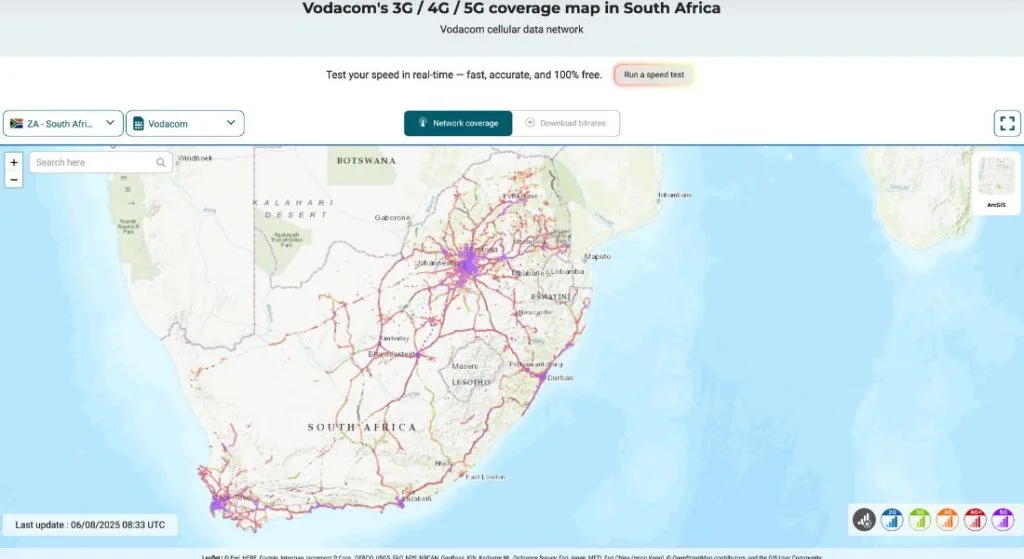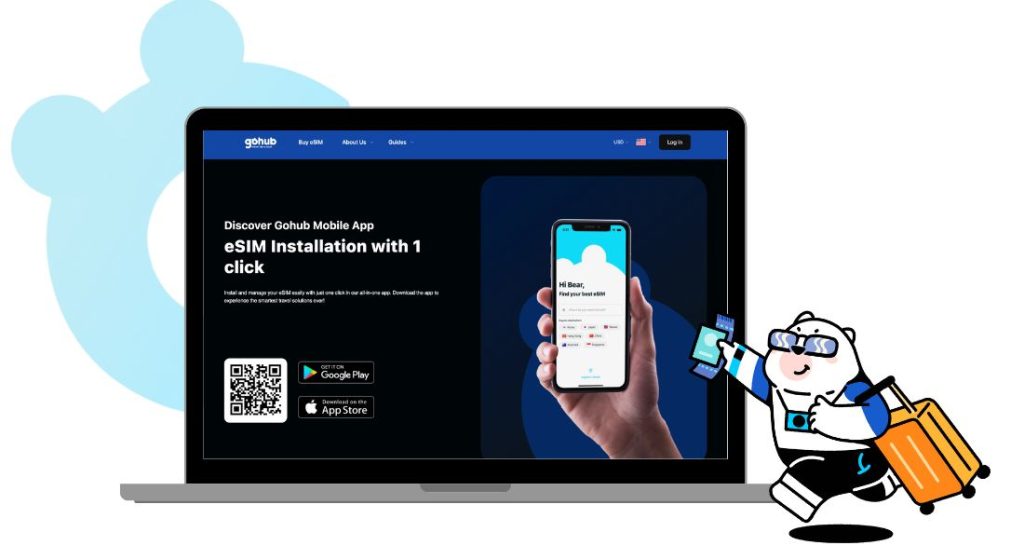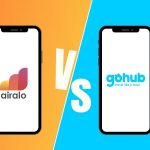Imagine this: you’ve just landed in Johannesburg, Cape Town, Nairobi, or Marrakech. You step off the plane, ready to chase wildlife, taste spicy street food, and lose yourself in ancient landscapes. But there’s a problem… you’re offline. No signal. No Uber. No Google Maps. No “Hi Mom, I made it!”
That’s where eSIMs come in.
In this guide, we’ll show you exactly how to choose the best eSIM for Africa—one that gives you instant internet the moment you land, without the SIM card hunt, outrageous roaming fees, or confusing setups in a new country.
You’ll learn:
- What makes an eSIM ideal for travel across Africa
- How to set it up before your flight
- The top eSIM providers for South Africa and beyond
- How to avoid data throttling, activation hiccups, and hidden costs
- And why savvy travelers are ditching physical SIMs altogether
Whether you’re off to spot lions in the Serengeti, sip wine in Stellenbosch, or explore the spice alleys of Zanzibar—this guide will help you stay connected, confidently and affordably.
First time exploring Africa on your own?
👉 Read our solo travel guide for tips, routes & confidence boosts!
I. What Makes an eSIM the Best for Travel in Africa?
Not all eSIMs are created equal—especially when you’re traveling across a diverse, vast, and often under-connected continent like Africa.
So what separates the “just okay” options from the best eSIM for Africa?
Here’s what truly matters:
1. Reliable Coverage in the Right Places
Africa is huge—and mobile infrastructure varies a lot by region. The best eSIMs should connect you to top-tier local networks like Vodacom, MTN, Telkom, and Orange, offering solid 4G/5G speeds even outside the big cities.
💡 Pro Tip: Look for eSIM providers that partner with multiple networks, allowing automatic switching to the strongest available signal.

2. Instant Activation and Simple Setup
You don’t want to fiddle with SIM trays at the airport or rely on sketchy airport Wi-Fi. The best travel eSIMs for Africa should let you:
- Purchase online in minutes
- Scan a QR code or install via app
- Activate only when you land (to preserve validity)
✈️ Set it up before takeoff. Turn it on after landing. Done.
3. Flexible Data Plans That Match Your Travel Style
Whether you’re:
- A casual traveler needing 3–5GB for a week, or
- A digital nomad hopping across borders for a month…
The best eSIMs should offer:
- Flexible durations (7 days, 15 days, 30+ days)
- Regional plans (for multi-country trips)
- Transparent pricing with no sneaky fees
4. Built-in Security
Public Wi-Fi in airports, hostels, and coffee shops? Not always safe.
Good eSIM providers include secure connection features, like:
- Malware blockers
- VPN add-ons
- Virtual IP routing
Especially important if you’re working remotely, accessing banking apps, or just value your privacy while traveling.
5. Hotspot Support and Dual SIM Flexibility
Make sure your eSIM allows tethering so you can share data with your laptop or travel buddy.
Bonus if you can run the eSIM alongside your physical SIM to keep your original number for texts and 2FA codes.
6. VoIP & Messaging Compatibility
Most travel eSIMs are data-only, but that’s more than enough if you’re using:
- FaceTime
- Google Voice
- Telegram
- Facebook Messenger
Some advanced eSIMs also offer talk/text add-ons, or virtual numbers if you need to make local calls.
7. Helpful Customer Support (Especially When You’re Offline)
Nothing kills your vibe like arriving in Namibia and finding out your data plan didn’t activate.
The best providers offer:
- 24/7 live chat
- Easy troubleshooting guides
- Quick refund policies if something doesn’t work
II. Best eSIM Providers for Africa: Compare the Top Options
So, who really delivers the best eSIM for Africa?
There’s no one-size-fits-all answer—but depending on your travel style, destination, and data needs, here are the top contenders worth considering:
1. Gohub – Best Overall for Smart Travelers
If you’re looking for unbeatable value, instant setup, and support that actually cares—Gohub eSIM is built for you.
Why Gohub stands out:
- ⚡ Instant activation—install before you fly, connect the moment you land
- 📶 Works on top African networks like Vodacom, MTN, Telkom
- 💸 Up to 50% cheaper than Airalo or Holafly
- 💬 24/7 multilingual support (yes, real humans!)
- ✅ 100% refund guarantee if it doesn’t work
Ideal for: Backpackers, solo travelers, remote workers, and anyone who hates airport SIM chaos

2. Airalo – Widely Known, Reliable, Slightly Pricier
Airalo’s “Bonjour Africa” plan offers multi-country coverage across Africa, with a smooth app and solid uptime.
- ✅ Easy-to-use app, popular globally
- ✅ 24/7 support
- ❌ Slightly higher per-GB pricing
- ❌ Throttled speeds reported after 5–10GB use
Ideal for: Brand-conscious travelers who want regional flexibility
3. Holafly – Unlimited Data, But Be Aware of FUP
Holafly promotes unlimited data plans for many African destinations. Sounds great—until Fair Usage Policy (FUP) kicks in.
- ✅ Easy setup, especially for iPhones
- ✅ 24/7 multilingual support
- ❌ Speeds may throttle after ~4–5GB/day
- ❌ No hotspot/tethering allowed
Ideal for: Short stays with heavy browsing/Instagram use, not remote work
🎯 Other Notable Providers
| Provider | Key Strengths | Best For | Limitations |
|---|---|---|---|
| Saily | VPN-backed, privacy-first, secure eSIM | Security-focused travelers | No unlimited plan or credit system |
| Nomad | Big-data plans, up to 50GB | Long-term travelers/digital nomads | Limited African country coverage |
| aloSIM | Offers talk & text packages via Hushed app | Business travelers needing SMS | Requires separate app setup |
| Instabridge | Pay-as-you-go options + global plans | Minimalists or flexible explorers | UI may feel limited |
| GigSky | Cruise + land plans, 100MB free trial | First-time eSIM users | High cost per GB after free trial |
🧳 TL;DR: Which eSIM is Best for Africa?
| Provider | Best For | Starting Price | Hotspot | Unlimited | Setup |
|---|---|---|---|---|---|
| Gohub | All-around value + local support | From $4.99 | ✅ | ❌ | Easy |
| Airalo | Multi-country flexibility | From $9.00 | ✅ | ❌ | Easy |
| Holafly | Unlimited data fans | From $19.00 | ❌ | ⚠️ (FUP) | Easy |
| Saily | Privacy-conscious travelers | From $5.00 | ✅ | ❌ | Easy |
| Nomad | Heavy data users, long trips | From $14.00 | ✅ | ❌ | Easy |
III. How to Set Up and Use Your eSIM in Africa
A Step-by-Step Guide (Before & During Your Trip)
Getting your eSIM ready before your African adventure is way easier than it sounds—you don’t need to be tech-savvy, just follow a few simple steps.
Here’s exactly how to do it:
Before Your Flight: Prep Like a Pro
✅ 1. Check If Your Phone Supports eSIM
Most modern phones do, but here’s how to check:
- iPhone: iPhone XR and newer → Settings > Cellular > Add eSIM
- Samsung: S20 and newer → Settings > Connections > SIM manager
- Google Pixel: Pixel 4 and up → Settings > Network & internet > SIMs
💡 If unsure, just Google your model with “eSIM support” or ask your eSIM provider’s support team.
✅ 2. Make Sure Your Phone Is Unlocked
Phones tied to carriers (e.g., AT&T, Verizon) may need unlocking. Contact your carrier—it’s usually free.
✅ 3. Buy and Install the eSIM Before Departure
Why? You’ll need internet to install your eSIM.
Choose your plan → receive a QR code or activation link → scan or open in-app.
- With Gohub, setup takes under 2 minutes
- You can install now and activate later (see below)
Upon Arrival: Activate and Go
✅ 1. Turn On Your eSIM
- Go to Settings > Mobile/Cellular
- Select your eSIM profile
- Turn ON Data Roaming
📌 Don’t worry—this won’t trigger any surprise charges. You’re using your prepaid eSIM data, not your home plan.
✅ 2. Check Signal & Start Browsing
You should connect to the strongest local partner network automatically (e.g., MTN, Vodacom).
If not, manually select a carrier in Network Selection settings.
✅ 3. Track Your Data
Most providers let you:
- See data usage in their app or device settings
- Set alerts at 80–90% usage
- Top up instantly if needed
Bonus Tips
- Save your original SIM (keep it safe!)
- Use Dual SIM mode if you need to receive texts/2FA from your home number
- Enable hotspot to share data with your laptop or travel buddy
- If using WhatsApp: it works the same—even with a data-only eSIM
- Still offline? Restart phone → re-check data roaming → switch network manually
IV. Can You Use eSIMs for Calls and Texts in Africa?
(And What About WhatsApp, VoIP, or Virtual Numbers?)
This is one of the most common questions travelers ask—and the answer depends on the type of eSIM you choose.
Let’s break it down:
Most eSIMs Are Data-Only
The majority of travel eSIMs for Africa are data-only, which means:
- ✅ Internet access for browsing, maps, apps, hotspot
- ❌ No local phone number for traditional calls/SMS
But here’s the good news…
You Can Still Make Calls & Send Messages Using Apps
With a data eSIM, you can use VoIP (Voice over Internet Protocol) apps that are way better than old-school texting:
- WhatsApp: Stay connected with your existing number (even if your SIM is different)
- Facebook Messenger / Instagram DMs: Message friends or locals
- FaceTime / iMessage (on iPhone)
- Telegram / Viber / Skype: Great for international calling
- Google Meet / Zoom: Perfect for business travelers
💡 If you had WhatsApp on your phone before installing the eSIM, it will still use your original number—even with a different data line!
Need a Local Number? Here’s What to Do:
If you need a local African number for things like:
- Making domestic calls
- Receiving confirmation SMS
- Booking local services that require a number
You have 3 main options:
🔹 1. Use Your Physical SIM for Calls
Activate eSIM for data, and keep your home SIM active for calls/texts (Dual SIM setup).
⚠️ Be aware: your home carrier may charge roaming fees for any calls/SMS.
🔹 2. Use a VoIP App with Virtual Number
Some providers (like aloSIM or Yesim) offer virtual phone numbers via partner apps (e.g. Hushed, Numero eSIM).
Pros:
- Looks like a local number
- Can send/receive calls and SMS
- Lower cost than roaming
Cons:
- Requires extra app setup
- May not work for all verifications (e.g. banks)
🔹 3. Use Rebtel or Similar Calling Apps
Apps like Rebtel give you super low rates for calling African numbers, even if you’re using a data-only connection.
So, Do You Need Call/Text with Your eSIM?
Probably not—unless:
- You’re traveling for work
- You need to register for local services
- You plan to make lots of domestic calls in places with weak data coverage
For most travelers (especially digital nomads and backpackers), a data-only eSIM + WhatsApp = all you need.
V. eSIM vs. Local SIM Card in Africa: Which One Should You Choose?
So, you’re planning your African adventure and stuck between two choices:
- Should I get a local physical SIM card when I land?
- Or go with a prepaid eSIM I can install before takeoff?
Let’s compare both options—the good, the bad, and the “I just want internet now.”
Option 1: Local SIM Cards (Old School Method)
✅ Pros:
- Sometimes slightly cheaper per GB
- Gives you a local phone number
- Available at major airports, local stores, malls
❌ Cons:
- Requires your phone to be unlocked
- Often involves long airport queues
- May require passport + local address for registration
- Can be confusing with local language barriers
- Setup may include manual APN configuration
- Not always available after hours or in rural regions
✈️ Real talk: If you’re landing at 10 PM in Nairobi, searching for a SIM booth is the last thing you want to do.
Option 2: eSIM (The Instant, Hassle-Free Way)
✅ Pros:
- Install before your trip and activate when you land
- No physical SIM = no risk of losing it
- No documents, no language barrier, no store visits
- Usually supports hotspot and dual SIM setup
- Safe from SIM swapping, theft, or poor vendor setups
❌ Cons:
- Slightly higher upfront cost per GB
- Doesn’t usually come with a local number (unless using a virtual number app)
💡 With Gohub, you’re online by the time your bags hit the carousel.
Cost vs. Convenience: What’s Worth More?
| Feature | Local SIM | eSIM |
|---|---|---|
| Setup Time | 30–60 min | Under 5 min |
| Requires Documents | Often yes | Never |
| Risk of Error | Medium–High | Low |
| Network Flexibility | 1 provider only | Multi-network |
| Local Number | ✅ | ❌ (unless VoIP) |
| Reliability | Varies by vendor | High (Gohub, Airalo, etc.) |
Final Verdict:
If you love simplicity, speed, and starting your trip stress-free → eSIM is hands-down the smarter choice.
But if you’re staying long-term, want a local number for calls, and are okay spending time comparing physical plans on arrival, a local SIM might make sense.
VI. Practical Tips & Troubleshooting for eSIM Travel in Africa
Real-World Advice to Stay Connected Without a Hitch
You’ve picked the best eSIM for Africa, installed it like a pro, and you’re ready to explore. But let’s make sure your connection doesn’t drop halfway through a safari or in the middle of a video call from Cape Town.
Here’s how to stay fully in control of your data connection:
1. Print or Save the QR Code Before You Fly
You’ll need an internet connection to activate your eSIM. If you’re planning to install it manually:
- Screenshot or print the QR code
- Keep a PDF copy offline on your phone or laptop
If using an app like Gohub, Airalo, or Holafly—make sure the app is already installed and logged in.
2. Manually Select a Local Network if Needed
Sometimes your eSIM won’t connect automatically—no panic!
Steps:
- Go to Settings > Mobile Network > Network Selection
- Turn OFF “automatic”
- Choose from available networks (e.g., MTN, Vodacom, Telkom)
💡 Gohub eSIMs usually auto-switch to the strongest network in your region, but you can always fine-tune manually.
3. Monitor Your Data Like a Boss
Apps like Gohub, Airalo, or Nomad typically include:
- Real-time data usage tracking
- Alerts when you hit 80% or 90% of your data
- One-tap top-up or plan extension
If your provider doesn’t offer this, check:
- Settings > Mobile Data > Data Usage on your phone
4. Use Hotspot Smartly
Most travel eSIMs allow hotspot/tethering, but check your provider’s FAQ.
Tips:
- Turn it off when not in use to save battery/data
- Lower screen brightness and background sync on connected devices
- Avoid streaming YouTube on full HD if you’re on a limited plan!
5. Fix Common eSIM Issues Fast
Problem: No service after activation
✅ Solution: Restart phone → turn data roaming ON → try manual network select
Problem: Can’t scan QR code
✅ Solution: Enter settings manually using the code in your email or app
Problem: Plan expired early
✅ Solution: Double-check when you activated it—some plans are valid from activation, others from installation
Problem: WhatsApp not recognizing your number
✅ Solution: Go to Settings > Account > Change Number to re-verify, or keep physical SIM in dual mode
6. Refunds and Support
Some eSIM providers (like Gohub) offer:
- Full refunds if the eSIM doesn’t work
- Fast response via live chat support, even from remote areas
🧳 If you’re halfway across Namibia with no data, it’s comforting to know someone’s got your back.
VII. Conclusion: Stay Connected and Explore Africa Without Limits
From the windswept dunes of Namibia to the buzzing streets of Cape Town, or the markets of Marrakesh to the gorilla trails of Uganda—staying connected in Africa shouldn’t be complicated.
Gone are the days of overpriced roaming and fumbling with local SIM cards at the airport. With the right eSIM, you can land connected, explore with confidence, and share your journey without missing a beat.
To recap, the best eSIM for Africa should offer:
- Fast, reliable coverage on trusted local networks
- Easy setup (install before you fly, activate on arrival)
- Transparent pricing, flexible plans, and no shady fees
- Real human support, when and where you need it
Whether you’re heading out on a wildlife safari, working remotely from a beach lodge, or city-hopping across the continent—Gohub makes sure you’re never out of reach.
🌍 Ready to make travel simpler, safer, and more connected?
Choose your Gohub eSIM for Africa today—and let your next adventure start online, stress-free, and fully in the moment.
VIII. FAQs
Q: What is the best eSIM for Africa travel?
A: GoHub is one of the best eSIM options for Africa—offering fast activation, Digicel and MTN coverage, 24/7 support, and plans from $4.99.
Q: Can I use an eSIM in South Africa, Kenya, or Morocco?
A: Yes! Most major African countries support eSIMs. GoHub connects to local networks like Vodacom, MTN, and Orange for reliable service.
Q: Do African eSIMs work for WhatsApp and hotspot?
A: Absolutely. With a GoHub eSIM, you can use WhatsApp, enable hotspot, and share data with other devices—just like a normal mobile plan.
Q: Is eSIM better than a local SIM card in Africa?
A: For most travelers, yes. eSIMs offer instant setup, no paperwork, and reliable coverage—perfect for safaris, city trips, and remote work.








